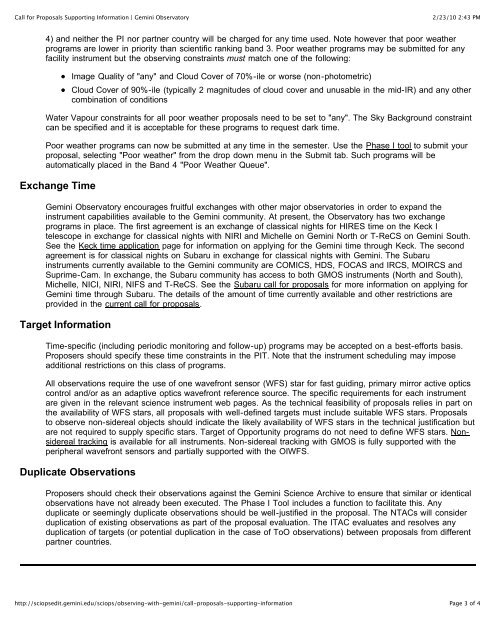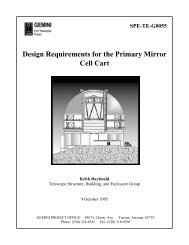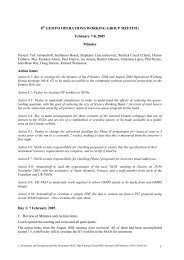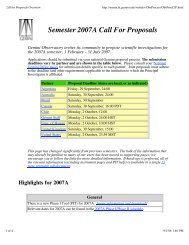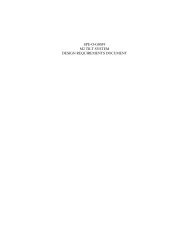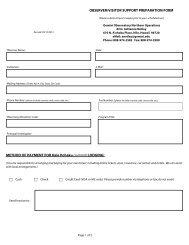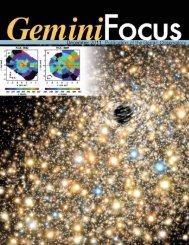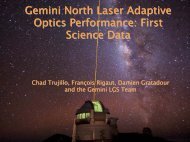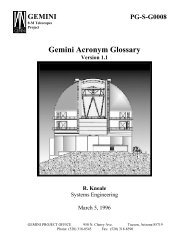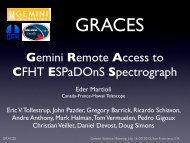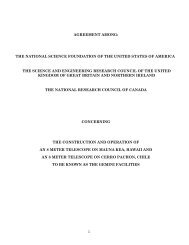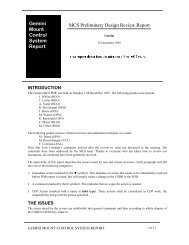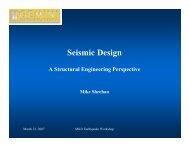pdf document - Gemini Observatory
pdf document - Gemini Observatory
pdf document - Gemini Observatory
Create successful ePaper yourself
Turn your PDF publications into a flip-book with our unique Google optimized e-Paper software.
Call for Proposals Supporting Information | <strong>Gemini</strong> <strong>Observatory</strong><br />
2/23/10 2:43 PM<br />
4) and neither the PI nor partner country will be charged for any time used. Note however that poor weather<br />
programs are lower in priority than scientific ranking band 3. Poor weather programs may be submitted for any<br />
facility instrument but the observing constraints must match one of the following:<br />
Image Quality of "any" and Cloud Cover of 70%-ile or worse (non-photometric)<br />
Cloud Cover of 90%-ile (typically 2 magnitudes of cloud cover and unusable in the mid-IR) and any other<br />
combination of conditions<br />
Water Vapour constraints for all poor weather proposals need to be set to "any". The Sky Background constraint<br />
can be specified and it is acceptable for these programs to request dark time.<br />
Poor weather programs can now be submitted at any time in the semester. Use the Phase I tool to submit your<br />
proposal, selecting "Poor weather" from the drop down menu in the Submit tab. Such programs will be<br />
automatically placed in the Band 4 "Poor Weather Queue".<br />
Exchange Time<br />
<strong>Gemini</strong> <strong>Observatory</strong> encourages fruitful exchanges with other major observatories in order to expand the<br />
instrument capabilities available to the <strong>Gemini</strong> community. At present, the <strong>Observatory</strong> has two exchange<br />
programs in place. The first agreement is an exchange of classical nights for HIRES time on the Keck I<br />
telescope in exchange for classical nights with NIRI and Michelle on <strong>Gemini</strong> North or T-ReCS on <strong>Gemini</strong> South.<br />
See the Keck time application page for information on applying for the <strong>Gemini</strong> time through Keck. The second<br />
agreement is for classical nights on Subaru in exchange for classical nights with <strong>Gemini</strong>. The Subaru<br />
instruments currently available to the <strong>Gemini</strong> community are COMICS, HDS, FOCAS and IRCS, MOIRCS and<br />
Suprime-Cam. In exchange, the Subaru community has access to both GMOS instruments (North and South),<br />
Michelle, NICI, NIRI, NIFS and T-ReCS. See the Subaru call for proposals for more information on applying for<br />
<strong>Gemini</strong> time through Subaru. The details of the amount of time currently available and other restrictions are<br />
provided in the current call for proposals.<br />
Target Information<br />
Time-specific (including periodic monitoring and follow-up) programs may be accepted on a best-efforts basis.<br />
Proposers should specify these time constraints in the PIT. Note that the instrument scheduling may impose<br />
additional restrictions on this class of programs.<br />
All observations require the use of one wavefront sensor (WFS) star for fast guiding, primary mirror active optics<br />
control and/or as an adaptive optics wavefront reference source. The specific requirements for each instrument<br />
are given in the relevant science instrument web pages. As the technical feasibility of proposals relies in part on<br />
the availability of WFS stars, all proposals with well-defined targets must include suitable WFS stars. Proposals<br />
to observe non-sidereal objects should indicate the likely availability of WFS stars in the technical justification but<br />
are not required to supply specific stars. Target of Opportunity programs do not need to define WFS stars. Nonsidereal<br />
tracking is available for all instruments. Non-sidereal tracking with GMOS is fully supported with the<br />
peripheral wavefront sensors and partially supported with the OIWFS.<br />
Duplicate Observations<br />
Proposers should check their observations against the <strong>Gemini</strong> Science Archive to ensure that similar or identical<br />
observations have not already been executed. The Phase I Tool includes a function to facilitate this. Any<br />
duplicate or seemingly duplicate observations should be well-justified in the proposal. The NTACs will consider<br />
duplication of existing observations as part of the proposal evaluation. The ITAC evaluates and resolves any<br />
duplication of targets (or potential duplication in the case of ToO observations) between proposals from different<br />
partner countries.<br />
http://sciopsedit.gemini.edu/sciops/observing-with-gemini/call-proposals-supporting-information<br />
Page 3 of 4


